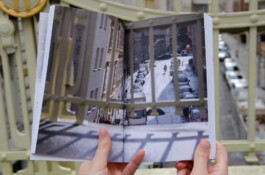Together in Public
London Pleasure Gardens:
Performative Inhabitable Gates
in collaboration with İklim Doğan
three gates in London, based on a study of pleasure gardens, mechanisms of access and exclusion, as well as doors, gates, triumphal arches, their symbolics and performative moments
unquiet – polyrhythmic – dissent – perpetual negotiation – monument
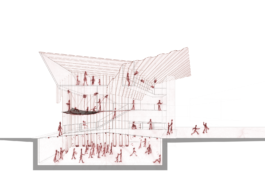
“Rehearsal Gate,” occupied section perspective
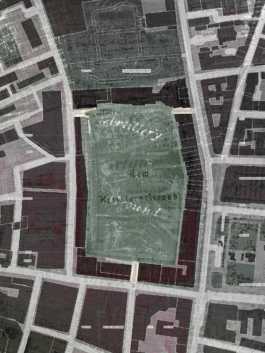
Artillery Ground, London, site plan, scale 1:2.000
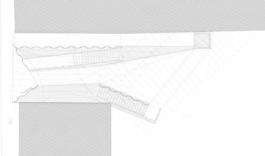
Access ways, plan +1.0, scale 1:50
How can architecture become a tool for political protest? How do we design a construction that can be re-adjusted? How can we support bodily interaction without prescribing activities?
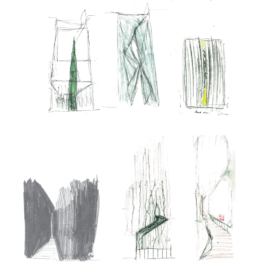
Gates
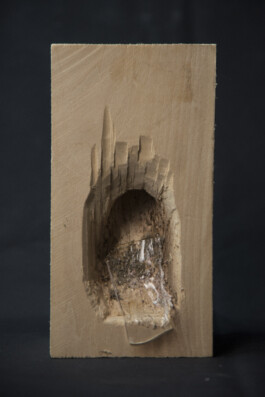
Carving in (c)I.D.
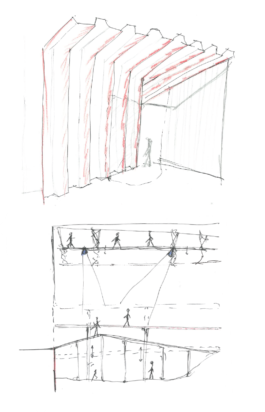
Visible access
Audible exchange
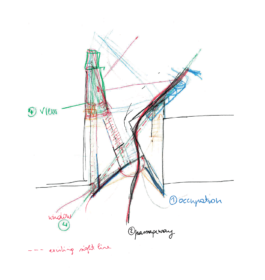
Affordances
Reciprocity in Political Architecture
catalysing perpetual interaction and prolonged articulation
Articulation and interaction of one body towards an other creates a political moment. A political movement is created by perpetual interaction and prolonged articulation of bodies in alliance. As architects we have the responsibility to provide our cities and its citizens with space that fosters perpetual interaction and prolonged articulation of bodies in alliance. [...]
The representative notion of gates and triumphal arches can be tackled. By turning the gate into a space in itself, that can be negotiated, changed and inhabited, the symbol becomes an affordance. According to James Gibson “[an] affordance cuts across the dichotomy of subjective-objective and helps us to understand its inadequacy. It is equally a fact of the environment and a fact of behavior. It is both physical and psychical, yet neither. An affordance points both ways, to the environment and to the observer.” (Gibson, James. The Ecological Approach to Visual Perception (1979) p. 129.) The gate, conceived as an affordance, is still a tool for exercising power: it is not imposing a fixed hierarchy, but it is rather empowering the people to perpetually negotiate existing relations. In doing so, the relation between the gates and the ample field is influenced as well. The gates catalyse activity on the field, and the field gives importance to the gates. This interdependency is a dynamic process, in which the activities of human beings are vital. [...]
Marcel Hénaff and Tracy B. Strong ask: “How can one be heard locally? Who controls the words that one hears? How may a space of and for discussion be constituted?” (Hénaff, Marcel and Strong, Tracy B. (Ed.). Public Space and Democracy (2001) p. 39.) These are questions that have to be asked in every architectural and artistic project, and they will always be answered differently, but this never-ending debate is what drives the evolution of thinking. Variations, intonations, extrapolations, deviations, improvisations, they all become part of this development, they do not just repeat, but tweak the existing. [...]
According to Henri Lefebvre, the conception of a new space can only be based on an architectural project. “Concrete utopia has its departure in spatial practice, in the effective appropriation of dominant space, an opportunity for a space of representation to take shape: that of pleasant habitations associated with definite but still multifunctional structures.”(Lefebvre, Henri. Toward an Architecture of Enjoyment (2014, written in 1973) p.141.) Concrete utopia begins with enjoyment and the pursuit to change architecture. Therefore, we must change the mode of its production.
(read full essay here)
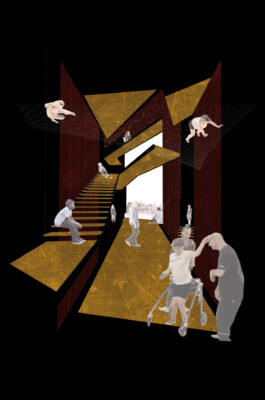
Spatial Experience
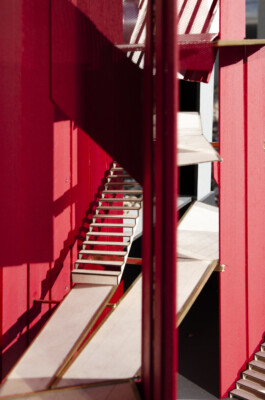
Spatial Experience, model, scale 1:33
This Master Studio Project was supervised by Cristina Díaz Moreno and Efrén Garcia Grinda on the platform Analogue and Digital Production, at the Institute of Art and Architecture, Academy of Fine Arts Vienna, WS 2018/19.
Together in Public
London Pleasure Gardens:
Performative Inhabitable Gates
in collaboration with İklim Doğan
three gates in London, based on a study of pleasure gardens, mechanisms of access and exclusion, as well as doors, gates, triumphal arches, their symbolics and performative moments
unquiet – polyrhythmic – dissent – perpetual negotiation – monument

“Rehearsal Gate,” occupied section perspective

Artillery Ground, London, site plan, scale 1:2.000

Access ways, plan +1.0, scale 1:50
How can architecture become a tool for political protest? How do we design a construction that can be re-adjusted? How can we support bodily interaction without prescribing activities?

Gates

Carving in (c)I.D.

Visible access
Audible exchange

Affordances
Reciprocity in Political Architecture
catalysing perpetual interaction and prolonged articulation
Articulation and interaction of one body towards an other creates a political moment. A political movement is created by perpetual interaction and prolonged articulation of bodies in alliance. As architects we have the responsibility to provide our cities and its citizens with space that fosters perpetual interaction and prolonged articulation of bodies in alliance. [...]
The representative notion of gates and triumphal arches can be tackled. By turning the gate into a space in itself, that can be negotiated, changed and inhabited, the symbol becomes an affordance. According to James Gibson “[an] affordance cuts across the dichotomy of subjective-objective and helps us to understand its inadequacy. It is equally a fact of the environment and a fact of behavior. It is both physical and psychical, yet neither. An affordance points both ways, to the environment and to the observer.” (Gibson, James. The Ecological Approach to Visual Perception (1979) p. 129.) The gate, conceived as an affordance, is still a tool for exercising power: it is not imposing a fixed hierarchy, but it is rather empowering the people to perpetually negotiate existing relations. In doing so, the relation between the gates and the ample field is influenced as well. The gates catalyse activity on the field, and the field gives importance to the gates. This interdependency is a dynamic process, in which the activities of human beings are vital. [...]
Marcel Hénaff and Tracy B. Strong ask: “How can one be heard locally? Who controls the words that one hears? How may a space of and for discussion be constituted?” (Hénaff, Marcel and Strong, Tracy B. (Ed.). Public Space and Democracy (2001) p. 39.) These are questions that have to be asked in every architectural and artistic project, and they will always be answered differently, but this never-ending debate is what drives the evolution of thinking. Variations, intonations, extrapolations, deviations, improvisations, they all become part of this development, they do not just repeat, but tweak the existing. [...]
According to Henri Lefebvre, the conception of a new space can only be based on an architectural project. “Concrete utopia has its departure in spatial practice, in the effective appropriation of dominant space, an opportunity for a space of representation to take shape: that of pleasant habitations associated with definite but still multifunctional structures.”(Lefebvre, Henri. Toward an Architecture of Enjoyment (2014, written in 1973) p.141.) Concrete utopia begins with enjoyment and the pursuit to change architecture. Therefore, we must change the mode of its production.
(read full essay here)

Spatial Experience

Spatial Experience, model, scale 1:33
This Master Studio Project was supervised by Cristina Díaz Moreno and Efrén Garcia Grinda on the platform Analogue and Digital Production, at the Institute of Art and Architecture, Academy of Fine Arts Vienna, WS 2018/19.
further projects:
